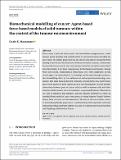Files in this item
Biomechanical modelling of cancer : agent‐based force‐based models of solid tumours within the context of the tumour microenvironment
Item metadata
| dc.contributor.author | Macnamara, Cicely K. | |
| dc.date.accessioned | 2021-05-28T11:30:07Z | |
| dc.date.available | 2021-05-28T11:30:07Z | |
| dc.date.issued | 2021-06 | |
| dc.identifier | 273356116 | |
| dc.identifier | 62165520-9098-43c2-b810-82bdde9489ca | |
| dc.identifier | 85114032224 | |
| dc.identifier.citation | Macnamara , C K 2021 , ' Biomechanical modelling of cancer : agent‐based force‐based models of solid tumours within the context of the tumour microenvironment ' , Computational and Systems Oncology , vol. 1 , no. 2 , e1018 . https://doi.org/10.1002/cso2.1018 | en |
| dc.identifier.issn | 2689-9655 | |
| dc.identifier.other | Jisc: 1483e4e0f37b4199a4426703c15dae87 | |
| dc.identifier.other | Jisc: 1483e4e0f37b4199a4426703c15dae87 | |
| dc.identifier.other | publisher-id: cso21018 | |
| dc.identifier.uri | https://hdl.handle.net/10023/23268 | |
| dc.description | Funding: CKM gratefully acknowledges the support of EPSRC Grant No. EP/N014642/1 (EPSRC Centre for Multiscale Soft Tissue Mechanics - With Application to Heart & Cancer). | en |
| dc.description.abstract | Once cancer is initiated, with normal cells mutated into malignant ones, a solid tumour grows, develops and spreads within its microenvironment invading the local tissue; the disease progresses and the cancer cells migrate around the body leading to metastasis, the formation of distant secondary tumours. Interactions between the tumour and its microenvironment drive this cascade of events which have devastating, if not fatal, consequences for the human host/patient. Among these interactions, biomechanical interactions are a vital component. In this review paper, key biomechanical relationships are discussed through a presentation of modelling efforts by the mathematical and computational oncology community. The main focus is directed, naturally, towards lattice‐free agent‐based, force‐based models of solid tumour growth and development. In such models, interactions between pairs of cancer cells (as well as between cells and other structures of the tumour microenvironment) are governed by forces. These forces are ones of repulsion and adhesion, and are typically modelled via either an extended Hertz model of contact mechanics or using Johnson–Kendal–Roberts theory, both of which are discussed here. The role of the extracellular matrix in determining disease progression is outlined along with important cell‐vessel interactions which combined together account for a great proportion of Hanahan and Weinberg's Hallmarks of Cancer. | |
| dc.format.extent | 16 | |
| dc.format.extent | 2336466 | |
| dc.language.iso | eng | |
| dc.relation.ispartof | Computational and Systems Oncology | en |
| dc.subject | Agent‐based | en |
| dc.subject | Cancer growth and development | en |
| dc.subject | Force‐based | en |
| dc.subject | In silico tumours | en |
| dc.subject | Tumour microenvironment | en |
| dc.subject | QA Mathematics | en |
| dc.subject | QH301 Biology | en |
| dc.subject | RC0254 Neoplasms. Tumors. Oncology (including Cancer) | en |
| dc.subject | SDG 3 - Good Health and Well-being | en |
| dc.subject.lcc | QA | en |
| dc.subject.lcc | QH301 | en |
| dc.subject.lcc | RC0254 | en |
| dc.title | Biomechanical modelling of cancer : agent‐based force‐based models of solid tumours within the context of the tumour microenvironment | en |
| dc.type | Journal item | en |
| dc.contributor.sponsor | EPSRC | en |
| dc.contributor.institution | University of St Andrews. Statistics | en |
| dc.contributor.institution | University of St Andrews. Applied Mathematics | en |
| dc.identifier.doi | 10.1002/cso2.1018 | |
| dc.description.status | Peer reviewed | en |
| dc.identifier.grantnumber | EP/N014642/1 | en |
This item appears in the following Collection(s)
Items in the St Andrews Research Repository are protected by copyright, with all rights reserved, unless otherwise indicated.

